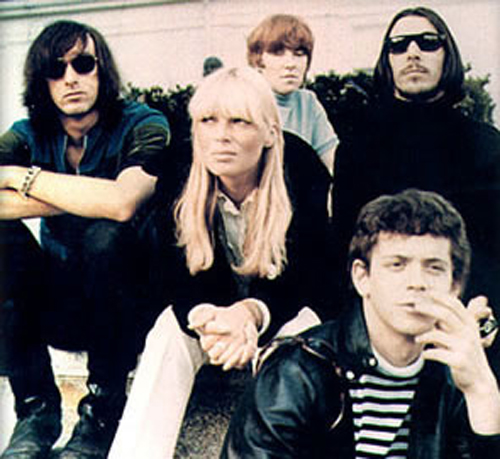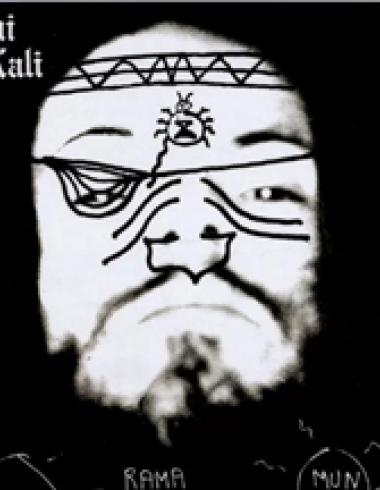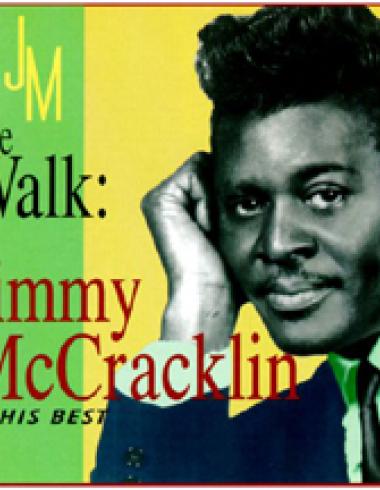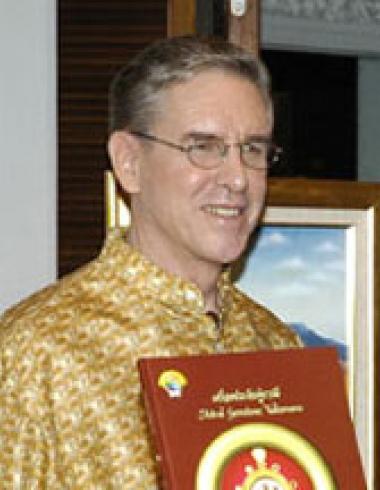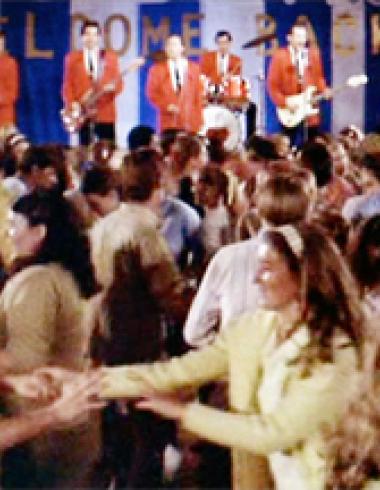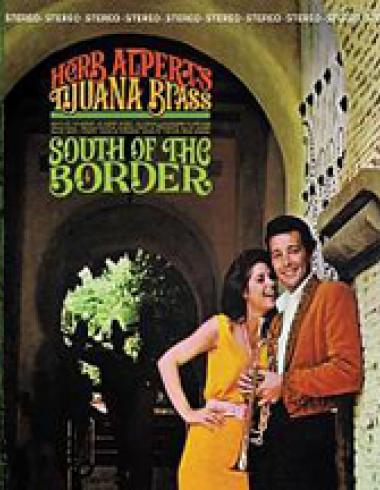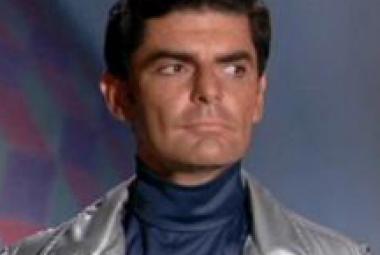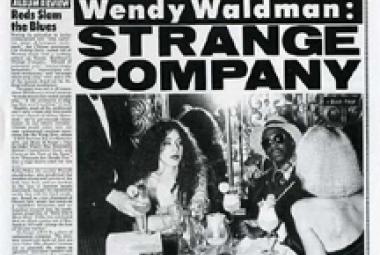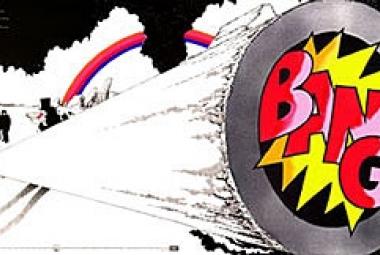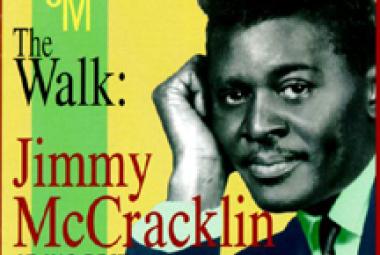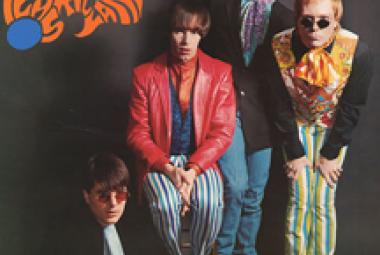Years ago, I heard that there was an unwritten rule among disc jockeys (maybe not unwritten in some places) that you were not supposed to play two songs with female singers one after another, under the theory that listeners wouldn’t be able to tell the songs apart. I cannot imagine that this has ever really been true, but it certainly wasn’t the case by the punk rock/new wave era: Picking artists almost at random, would anyone really have trouble distinguishing Blondie, Pat Benatar, Patti Smith, and Pretenders?
Anyway, in honor of this ridiculous notion, I am going to see how many UARB’s I can piece together, one after another, where at least half of the band is women. This is the third month, and I have at least two more in mind.
* * *
When women started showing up in otherwise male rock bands, they were normally the lead singers; but after awhile, women were as often on the musician side as the vocalist side. The roster of the classic line-up of the Velvet Underground – Lou Reed (lead vocals, electric guitar), John Cale (multi-instrumentalist), Sterling Morrison (bass guitar, electric guitar), and Moe Tucker (drums) – makes it seem that this classic band was an all-male group like virtually every other rock band in the 1960’s.
Actually the drummer’s real name is Maureen Tucker; her approach as a percussionist was outside the norm to say the least. Quoting from Wikipedia: “Her abbreviated drum kit was rather unusual: She generally played on tom toms and an upturned bass drum, using mallets as often as drumsticks, and she rarely used cymbals. . . . When her drums were stolen from one club, she replaced them with garbage cans, brought in from outside.”
Upon the death of Lou Reed in October 2013, the Velvet Underground has been celebrated once again. Allmusic calls them “the quintessential bohemian New York band of the ’60s that fused art, rock, and poetry in a fashion that proved incalculably influential”. The proto-punk side of the band is well known – indeed, it is as difficult to imagine punk and new wave without the Velvet Underground as it is to think that heavy metal would have come along without the Yardbirds – but their music was experimental throughout and also ran the gamut from garage rock (“I’m Waiting for the Man”) to ballads (“Stephanie Says”) to old-fashioned pop-rock (“There She Goes Again”, which was covered by R.E.M. – I learned about the song from the version of “There She Goes Again” recorded by the Crawdaddys).
Perhaps the biggest surprise is that the Velvet Underground often creates beautiful and mellow songs, and one need go no further than the opening track on their first album to find it – the laid-back “Sunday Morning” is every bit as lovely as a song with that name should be, but it is coming from the same band that created harrowing tales like “Heroin” and “Sister Ray”. A compilation album called VU collected several similarly mellow songs that were intended for the Velvet Underground’s never-released fourth album.
* * *
Album sales by the Velvet Underground were low in spite of the prominent connection with legendary pop artist Andy Warhol at the top of his fame. Though officially their producer, Andy Warhol’s input was evidently minimal, although he insisted on their including ethereal vocalist Nico on three songs on their first album, The Velvet Underground & Nico (1967). Warhol also contributed artwork for some of the band’s album covers, such as the peelable banana on that album. Brian Eno – another highly experimental musician – is the source of the famous quotation about this album: While selling only 30,000 copies, “everyone who bought one of those 30,000 copies started a band”.
After the Velvet Underground broke up, Lou Reed mounted a decades-long solo career that started with a bang: “Walk on the Wild Side” is hard to top as an I-can’t-believe-what-I’m-hearing song, but it was as irresistible in 1972 as it is today and made it to #16 on the Billboard singles charts. In 1989, he released his long-ranging album New York; as identified as Lou Reed is with New York City, he needed to bring the goods if he was going to use that album name, and does he ever. Allmusic calls New York the finest solo album of Lou Reed’s career.
Among the eulogies written about Lou Reed are some that compare his contributions to rock and roll to those of Bob Dylan and John Lennon, and I can’t really argue with that assessment. Also, many musicians, even great musicians spend a lot of time coasting in their later years, but this doesn’t ever seem to have been true of Lou Reed – he was on his game throughout his career. It wasn’t until after his death that I heard this quote by Lou Reed himself from 1989 that sums up his musical vision perfectly: “My interest – all the way back with the Velvets – has been in one really simple guiding-light idea: take rock and roll, the pop format, and make it for adults. With subject matter written for adults so adults, like myself, could listen to it.”
John Cale has also had an important impact on music following his time with the Velvet Underground, though mostly behind the scenes. He produced and arranged albums for a host of important bands and musicians, including three albums by Nico. Cale produced the first album by Patti Smith Group, Horses (1975), which had the kind of impact on the rock music scene that The Velvet Underground & Nico should have had. John Cale produced several proto-punk albums, including the first album by the Stooges, The Stooges (1969), and the first album by the Modern Lovers that Reprise Records refused to release; it was later released on Beserkley Records. Cale’s own solo albums are less well known and include collaborations with Lou Reed and Sterling Morrison.
* * *
Another example is Talking Heads; I dare say that some of their casual fans didn’t realize that Tina Weymouth (bass guitar and backing vocals) was playing alongside David Byrne (lead vocalist and guitar), Chris Frantz (drums and backing vocals), and Jerry Harrison (keyboards, guitar and backing vocals). I have always thought that David Byrne looks more like he should be an accountant than anyone else I know of in rock music.
Talking Heads formed in New York City in 1975 and stayed together until 1991. The band had several hit songs and albums and rock videos, as well as a concert film, Stop Making Sense; they were also a favorite of rock critics throughout the 1980’s. Favorites of mine include “Burning down the House”, “Psycho Killer” and “Life During Wartime”; actually the official title of the last song is “Life During Wartime (This Ain’t No Party . . . This Ain’t No Disco . . . This Ain’t No Foolin’ Around)”, and it is one of the longest song titles ever.
* * *
Tina Weymouth and Chris Frantz of Talking Heads (who have been married to each other since 1977) also had a successful side project, a more dance-oriented new wave band called Tom Tom Club. Tina’s sisters Laura Weymouth and Lani Weymouth were collaborators with them on this band; her brother Loric Weymouth is also credited on the first album, Tom Tom Club (1981). Guitarist Adrian Belew – who was an occasional guest performer with Talking Heads – played rhythm guitar on the band’s first album, which included their two hits, “Wordy Rappinghood” and “Genius of Love”, the latter being a long-time favorite of mine that has a really cool animated video. Afterward, Adrian Belew almost immediately joined King Crimson, where he was their front man from 1981 to 2009.
* * *
I saw the above album by Angie Pepper, It’s Just that I Miss You (2001) that was advertised in the Bomp! mailorder service as recommended for Blondie and Patti Smith fans, so I immediately ordered it. The CD actually covers music from the Passengers and the Angie Pepper Band. Allmusic calls her music psychedelic blues-rock and compares her to Janis Joplin. But she has a style all her own; Angie Pepper can bring such raw emotion to her singing that I get choked up when I hear her music, even after all these years. She is one of my very, very favorite rock artists: I know that I have easily played this CD 50 times and maybe 100 times; there were years when I was playing it several times a week.
Angie Pepper grew up as the youngest of three children in a middle class family in Newcastle, Australia. She was always interested in art and music and became part of the Sydney rock music scene. Angie became friends with the bandmembers in Radio Birdman, a legendary Sydney punk rock band that formed in 1974 and broke up in 1978. One of the bandmembers, guitarist Deniz Tek is actually from Detroit and brought the hard-edged Detroit sound of MC5 and Iggy and the Stooges with him Down Under.
Alex Wheaton, writing for dB Magazine said of this band: “Radio Birdman did it first, did it harder, and broke up sooner, than any other Australian band. They were too much too soon, and their legacy has been felt, through a slew of eighties pretenders right down to this day.”
Angie Pepper’s first significant band, the Passengers came together in 1979 out of the break-up of Radio Birdman, consisting mainly of musicians that she met through that connection. Their sound was heavily aligned with the girl group sound of the 1960’s; “Remember (Walking in the Sand)” by the Shangri-Las and “Baby, I Love You” by the Ronettes are songs that the Passengers frequently covered in their concerts. But mostly they played their own songs.
In an online interview on divinerites.com, Angie Pepper recalls her time in the Passengers: “It was wonderful. There wasn’t one gig I didn’t enjoy – I don’t think I’ve ever felt so good as when I played gigs with the Passengers. As far as the performances go, I was very much aware of the audience but I wasn’t afraid of the audience. When I was singing those songs with the Passengers, I meant every line I sang. and the band played with a lasting conviction that made it possible for me to really sing from my heart. I felt that I was revealing a very personal side of me that would be impossible for me to reveal in any other circumstances. Even though there were hundreds of people watching me, it felt okay to be that raw.”
As popular as they were in concert, the Passengers released only one single, “Face with No Name” b/w “Girlfriend’s Boyfriend” (the very first release on Phantom Records); and it is amazing that any more of their music is available. After their last gig, the bandmembers recorded demos of 8 of their songs in October 1979; Angie Pepper left the master in the hands of a friend, but only a cassette tape survived.
After the Passengers broke up, Angie Pepper and Deniz Tek quietly married and collaborated on a new band called the Angie Pepper Band. The other bandmembers were Clyde Bramley – later a member of the Sydney rock band Hoodoo Gurus – and former Saints drummer Ivor Hay. The Angie Pepper Band also released just one single in Australia, “Frozen World” b/w “Why Tell Me”.
* * *
In 2003, Angie Pepper released her first full-fledged album, Res Ipsa Loquitor (the name is taken from a Latin legal term meaning “the thing speaks for itself”). The album has a variety of moods and influences – even a short rap section – with most songs being co-written by Angie Pepper and Deniz Tek. Four of the tracks were recorded with a Montana psychedelic outfit called Donovan’s Brain (named after a 1942 science fiction novel, Donovan’s Brain that was made into a horror film on three occasions). The songs include a cover of the notorious “Hindu Gods (of Love)”, a linchpin Australian punk rock song; “Hindu Gods (of Love)” was originally released by Lipstick Killers on Greg Shaw’s Voxx Records in 1980.
* * *
After Kim Fowley lost control of the Runaways. the early all-female rock band that he helped found and also managed, he sought to form another band that was counter to the conventions of the day: a male lead singer that was backed by female musicians. Called Venus and the Razorblades, bandmembers were Steven T. (vocals and guitar), Roni Lee (rhythm guitar), Danielle Faye (bass guitar), Nicky Beat and later Kyle Raven (drums), and two more vocalists, Dyan Diamond and Vicki Arnold, aka Vicki Razor Blade. As with the Runaways, the musicians were teenagers; Arnold was 17, and Diamond was only 14.
Venus and the Razorblades released “Punk-a-Rama” as their first single on Bomp! Records, a terrific song that provided an overview of the early punk rock scene. I first encountered the song on Bomp’s initial compilation album, Best of Bomp, Volume One, which I recently cleaned up from Katrina. Venus and the Razorblades made several other singles, such as “I Wanna Be Where the Boys Are” and “Dog Food”; they broke up shortly thereafter. Kim Fowley eventually put together a retrospective album in 1978, Songs from the Sunshine Jungle; Wikipedia says that the album is extremely rare today, and I was delighted to find a copy at Criminal Records in Atlanta a few years ago.
Dyan Diamond released an acclaimed album in 1978 (produced by Kim Fowley), In the Dark that brings rockabilly and roots music to her new wave oeuvre; Allmusic gives the album 4½ stars and called it “a perfect example of an LP that was a creative triumph but a commercial disappointment”.
* * *
The Plasmatics were a controversial punk rock/heavy metal band that was formed by Yale University art school graduate Rod Swenson (who became their manager) and lead vocalist and front woman Wendy Orlean Williams. In many ways performance artists more than rock musicians, their concerts and rock videos featured exploding television sets and speaker cabinets, car crashes, and chain-sawing guitars in two. Wendy O. Williams wore a Mohawk hairdo in her days with the band and typically appeared in as little clothing as possible; she was once arrested for public indecency in Milwaukee.
In 1982, the Plasmatics toured as the opening act for KISS; at the conclusion of the tour, the band’s relationship with Capitol Records was frayed to the breaking point, so KISS frontman Gene Simmons approached Wendy O. Williams and Rod Swenson about recording their next album without the Plasmatics name. The result was released as a solo album by Wendy O. Williams called W.O.W. (1984) – with the album’s name taken from Williams’ initials – though the band’s website says that W.O.W. is still regarded as a Plasmatics album. Three members of KISS played on the album, Ace Frehley, Paul Stanley and Gene Simmons, with the latter credited as Reginald Van Helsing; Simmons also produced the album. Remarkably, Wendy O. Williams was nominated for a Grammy for Best Female Rock Vocal Performance in 1985, evidently for this album.
* * *
One of the early L.A. punk rock bands was the Pandoras, an all-female band that was formed in 1983 by bandleader Paula Pierce (lead vocals, guitar, harmonica) and Gwynne Kahn (organ and vocals). Pierce’s boyfriend at the time was Shelley Ganz, leader of a garage rock revival band called the Unclaimed; while Kahn was dating Joe Nolte who was in a similar band called the Last. Bambi Conway (bass and vocals) and Casey Gomez (drums) rounded out the original line-up of the Pandoras. Greg Shaw gave them a record deal and some studio time; the result was an excellent debut album on Bomp! Records called It’s About Time (1985).
Writing in the liner notes for the Bomp! Records compilation album Destination: Bomp! (1994), Greg Shaw writes of the Pandoras: “Someday, when all the ‘Riot Grrrl’ hype has died down, I hope Paula Pierce gets the credit she deserves for being the first to break the taboo against blatant sexual aggressiveness in female performers.”
There were some personnel shake-ups before the Pandoras released their second album for Rhino Records in 1986, Stop Pretending. The Pandoras then signed with Elektra Records through Paula Pierce’s boyfriend at the time, who was an A&R rep for the label; but the planned album was never officially released. Sadly, Paula Pierce died of a brain aneurysm in 1991 when she was just 31.
* * *
Another predecessor band to the “riot grrrl” scene was another all-woman rock band called L7; the name is a longtime slang term for “square”, since an “L” and a “7” in block lettering can form a box. The band was formed in Los Angeles in 1985 by guitarists and vocalists Donita Sparks and Suzi Gardner; bass guitarist Jennifer Finch and drummer Demetra “Dee” Plakas were then added.
L7 started out as a heavy metal band but had punk rock influences also. The band’s third album, Bricks Are Heavy came out in 1992 about six months after Nirvana’s Nevermind album became a massive hit; as a result, L7 became identified with the grunge movement that Nirvana launched. Bricks Are Heavy was named by Rolling Stone as one of the Essential Albums of the 1990’s. One track on the album, “Pretend We’re Dead” received a lot of airplay and MTV exposure; the song peaked at #8 on the Billboard Modern Rock Tracks charts.
* * *
Riot grrrl per se grew out of the hardcore punk scene in the early 1990’s and fused the power of that musical style with a strongly political feminist sensibility. Interestingly, riot grrrl was strong in both Washington’s: Washington, D.C. and Washington State, particularly Olympia. I am still learning about riot grrrl myself; but the above album, Pussy Whipped by Bikini Kill (their second) is a recent acquisition (in vinyl I might add). The album is an unadulterated blast of fury that is a compelling if somewhat challenging listen.
In the late 1980’s, three students at the liberal Evergreen College in Olympia, Kathleen Hanna, Tobi Vail and Kathi Wilcox began publishing a feminist fanzine called Bikini Kill. Guitarist Billy Boredom was recruited to buttress the band that they formed of the same name, Bikini Kill; as you might imagine, his presence in the line-up is under-stated.
The title of the first album by Bikini Kill, Revolution Girl Style Now (1991) sums up what the band was trying to accomplish. Music and concert conventions were set aside so that female audience members could be closest to the stage, with women encouraged to tell their stories of sexual abuse during the performances.
* * *
Another all-woman rock band that has been in the news lately is the Russian feminist punk/protest rock band Pussy Riot. Along with the provocative name, the band features an ever-changing line-up of musicians and often performs in disguise. In February 2012, Pussy Riot staged a protest at the Cathedral of Christ the Savior in Moscow, which was aimed at the leader of the Russian Orthodox Church who was supporting Vladimir Putin in his bid to be re-elected President of Russia (the band regards Putin as a dictator). After church security officers ejected the bandmembers, Pussy Riot quickly created a music video of their performance entitled “Punk Prayer – Mother of God, Chase Putin Away!”.
In August 2012, the Russian government charged three of the bandmembers in Pussy Riot – Nadezhda Tolokonnikova, Maria Alyokhina and Yekaterina Samutsevich – with “hooliganism motivated by religious hatred”; that’s rich considering that Russia’s government was vehemently atheistic barely two decades ago. While Samutsevich was later freed on appeal, the other two women were sentenced in October 2012 to two years in prison.
Opposition to their unfair imprisonment became a cause célèbre of many Western celebrities plus musicians from every genre imaginable: Bryan Adams, Beastie Boys, the Black Keys, John Cale, Peter Gabriel, Green Day, Nina Hagen, Kathleen Hanna, Paul McCartney, Moby, Yoko Ono, Pet Shop Boys, Red Hot Chili Peppers, Patti Smith, Sting, Pete Townshend, etc. Pussy Riot was featured on 60 Minutes as well.
For their part, the bandmembers in Pussy Riot that were not in prison distanced themselves from all of this attention and were quoted as saying: “We’re flattered, of course, that Madonna and Björk have offered to perform with us. But the only performances we’ll participate in are illegal ones. We refuse to perform as part of the capitalist system, at concerts where they sell tickets.”
A sweeping amnesty law that was passed in Russia in late December 2013 has ended their sentence. Although this law was derided as a publicity stunt in preparation for the upcoming 2014 Winter Olympics, it seems to me that we could use some amnesty in this country also.
Say what you want, I think that the culture of independence and individualism that is fostered by immersion in the rock aesthetic – rock music, particularly hard rock had a notable increase in popularity in Russia in the late 1980’s – had as much to do with the fall of the Soviet Union as the posturing by President Ronald Reagan at the Berlin Wall. The influence of music and musicians also hastened the fall of Czechoslovakia from the Iron Curtain ranks in what was known as the Velvet Revolution.
* * *
One year ago, this series of Facebook posts took a different turn as the discussions became more free-ranging and as the text was more liberally illustrated with photographs. The UARB in December 2012 was the Invisible Eyes – still one of my favorite bands of the bunch – and I remarked at the time that I first encountered them as the first of a trio of CD’s that also included probably the best of the Iguana Chronicles CD’s, Open Up and Bleed! by Iggy and the Stooges; and the CD Les Hell on Heels by this month’s UARB, LES HELL ON HEELS. This all-female hard rock band has been on the short list for UARB status ever since, and it is high time for me to get on with it.
Bandmembers in Les Hell on Heels are Paula Monarch (lead vocals and guitar), Katie Rose (guitar and vocals), Chela LaRue (bass guitar and vocals), and Kristin Machynski (drums). The band released their self-titled album in 2004 on Bomp! Records. Les Hell on Heels is from Phoenix, Arizona, and the bandmembers had been in two earlier bands. Paula Monarch and Chela LaRue had been in a garage punk band called the Peeps; they released a well regarded album on Sympathy for the Record Industry Records in 2000. Katie Rose and Kristin Machynski were previously bandmembers in Tempe Tramps.
Punk stalwart Jeff Dahl – whose resumé includes a stint in the Angry Samoans and recordings with Cheetah Chrome of the Dead Boys and Rikk Agnew of the Adolescents – had worked with both the Peeps and Tempe Tramps in the past. Jeff Dahl was instrumental in getting Les Hell on Heels signed by Greg Shaw of Bomp! Records – the CD was released shortly before Shaw’s death in 2004 – and Dahl also wrote one of the songs on the CD, “Ain’t So Cool”. Greg Shaw was quoted as saying of Les Hell on Heels: “I feel the same way that Phil Spector must have felt when he first saw the Ronettes.”
Writing for Allmusic, Ned Raggett says of the Les Hell on Heels CD: “If one word can cover everything here, it’s ‘swagger’ – songs like ‘He’s Alright’ and ‘Waste of Time’ could almost coin the term in both the singing and the brawling, rolling punch of the band (big credit to both Chela LaRue and drummer Kristin Machynski).” That’s not the only word Raggett introduces though; he calls the band’s music “snot-garage”.
Les Hell on Heels opens with “My Kind of Trouble” – the song title alone lets you know these gals aren’t messing around. The song features unexpected interplay among the vocalists on top of a pounding beat that never quits. Another standout track is the title song, “Hell on Heels” that has some great harmony vocals.
* * *
In 2007, Dionysus Records released the second album by Hell on Heels, Dogs, Records and Wine. On this album (which I don’t have as yet), Kristin Machynski has been replaced on drums by Jessica Roe, and Helene 33 has taken over on keyboards; also, the band name has been shortened slightly. Guest artists include Jeff Dahl and album producer Jack Endino on guitar, plus vocals from Nikki Corvette on two songs, “Pretty Mess” and “Made Like No Other”.
* * *
Flashback: The Under-Appreciated Rock Band of the Month for December 2011 – The Magicians
I was really scrambling to find someone who I could write about at that time; the post on the band that I had planned to talk about – Phil and the Frantics – wasn’t going at all well, and that post actually didn’t come out until August 2012. Then for some reason, I looked up the original Nuggets: Original Artyfacts from the First Psychedelic Era, 1965-1968 and noticed that there was one band on the two-LP set that still didn’t have an article. And incredibly, they still don’t!
YouTube has the Nuggets track by the Magicians, “An Invitation to Cry” in several locations, such as www.youtube.com/watch?v=wJB-DKoXD1A . This version has several wedding invitations and shots of brides and grooms, and the like. I only found one other song by the band, “And I’ll Tell the World (About You)”; this song can be heard at: www.youtube.com/watch?v=_oPxNrOzyFE . This is a soft-rock song that is more like their other songs, from what I have heard; “An Invitation to Cry” is the song with an edge.
* * *
Picture Gallery: The Under-Appreciated Rock Band of the Month for December 2010 – The Poppees
Here is the vinyl album by the Poppees that I have, Pop Goes the Anthology (it came out in CD also of course):
This is the first single by the Poppees, “If She Cries” b/w “Love of the Loved”, just the third to be released on Bomp! Records:
This is the jacket (both sides) for their second single, “Jealousy” b/w “She’s Got It”:
This is a clean shot of the photograph that is on the front cover of Pop Goes the Anthology:
Here is another photograph that is given on the back album cover:
* * *
Story of the Month: The Standells (from October 2010)
Besides the darling cover on The Piltdown Men by the Piltdown Men showing an r&r band of cave men and women plus dinosaurs, I spotted the name “E. Cobb” in the songwriting credits and wondered if that could possibly be Ed Cobb. And sure enough it was: As their producer and songwriter, Ed Cobb greatly influenced the musical direction of what had up until then been a conventional rock band called the Standells. The song that he wrote for the band called “Dirty Water” made it to #11 on the national charts and changed the Standells into true punk rock heroes: Not for nothing was this landmark garage rock song placed on Nuggets (the very first garage rock/psychedelic rock compilation album, released in 1972) as the second track, right after “I Had Too Much to Dream Last Night” by the Electric Prunes. Ed Cobb also wrote several more of the Standells’ most memorable songs, including the even fiercer “Barracuda” plus “Sometimes Good Guys Don’t Wear White” and “Why Pick on Me”. As a celebration of Boston and its River Charles, “Dirty Water” might seem like an odd choice for a Los Angeles band like the Standells; but Ed Cobb was from New England, so it was home to him.
Much to my amazement, Ed Cobb turned out to be a member of a band from the 1950’s called the Four Preps that could hardly be more different from the Piltdown Men and the Standells – come to think of it, those two later bands don’t have much in common either. While instrumental rock bands like the Piltdown Men are extremely scarce these days – though a fine surf/psychedelic band called the Mermen released a new album this year (their first since 2004) – the musical genre from which the Four Preps arose was considered old-fashioned by the mid-1960’s and is almost completely extinct today. These all-male, all-white singing groups often had names evocative of bourgeois college days – in addition to the Four Preps, examples include the Lettermen and the Four Freshmen – and they sang in precise three- or four-part harmonies with a clean-cut look. The Four Preps’ big hit was a long-time favorite of mine called “26 Miles (Santa Catalina)”, a paean to Santa Catalina Island off the coast of California: “the island of romance, romance, romance, romance”.
And who was responsible for the distinctive growling vocals in “Dirty Water” that prefigured the snarling, snotty singing in so many 1970’s and 1980’s punk rock bands? His name is Dick Dodd, who handled lead vocalist duties on most of the Standells’ records; and he had been one of the original Mouseketeers (and no relation to “Head Mouseketeer” Jimmie Dodd). You just never know where someone’s life is going to go no matter how they start out, do you?
